SCHUBERTH SR1 U.S.A. DOT Version
The SR1 was the webBikeWorld 2011 Motorcycle Helmet of the Year and we were anxiously awaiting the DOT version to arrive.
The good news is that the DOT version is identical to the ECE version of the SCHUBERTH SR1 (review) in every way but one.
The DOT helmet did gain a bit of weight, but that was expected.
The SR1 DOT version is loaded with the same SCHUBERTH technology and it remains as one of my all-time favorite motorcycle helmets.
And the best part is that it also fits me better than just about every other helmet I’ve worn — and that’s really something!
All you need to know about the U.S. DOT version of the SCHUBERTH SR1 is in my 2011 review of the SCHUBERTH SR1 ECE.
Read that review and you’ll also know everything about the new DOT version (more or less!).
Other than a couple of minor color differences for the chin and top vents and a weight gain that I’ll discuss, the SCHUBERTH SR1 DOT is identical in every way to the ECE-spec helmet I still have on hand.
So rather than repeat that entire review here, I’ll instead provide a simple “Quick Look” by way of an update on the DOT version.
We also took an extended photo set and the slide show below includes some comparisons of the ECE version (with black trim) to the new DOT version (white trim) for the U.S.A.
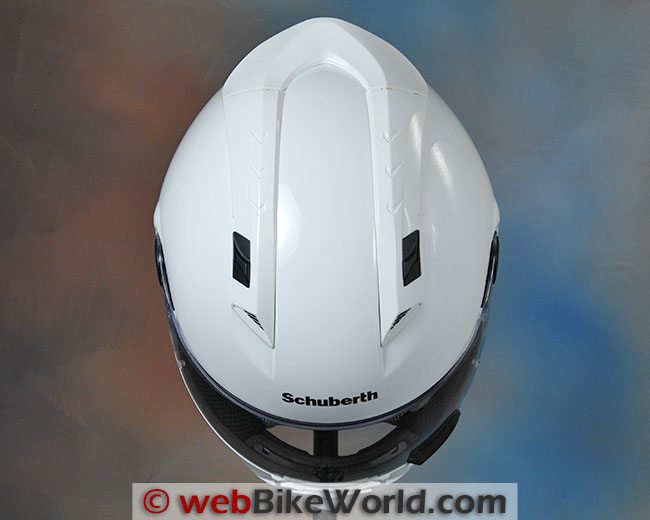
Where to Buy SCHUBERTH SR1 DOT Helmet
Check Reviews & Prices on Amazon Check Reviews & Prices On RevZillaSee More Motorcycle Helmets, Motorcycle Visor, Motorcycle Intercom
The SCHUBERTH SR1 DOT: General Comments
The good news is that all of the premium ingredients from the ECE version of SCHUBERTH SR1 are (as far as we can tell) included in the DOT version of the helmet now available for sale in the U.S. of A.
I’ve been following the development of the SR1 since the first prototypes were introduced back in 2010.
The helmet first appeared on the head of none other than Michael Schumacher, during his brief stint as a motorcycle racer after leaving Formula 1 for the first time. Schumi worked with SCHUBERTH to bring F1 technology to the SR1 motorcycle helmet.
Pulling the SR1 out of the box for the first time gives a sense of solidity matched only by a very few top-drawer helmets from manufacturers such as Arai and Shoei.
There’s something about a high-quality helmet that just feels different — kind of like it’s been machined from billet stock. The SR1 has that feeling, not doubt about it.
Overall Impressions
The overall fit and finish of the SR1 is excellent…as should be expected on a helmet costing (gulp!) a greenback short of 900 bucks. But when it comes to brain protection, cost is no object as far as I’m concerned.
I can say this: if I was going to crash, I’d rather be wearing the SR1 (and a full set of leathers) than just about any other helmet I can think of.
The SR1’s technology spec sheet is as long as The Great Khali’s arm.
And although I (thankfully) haven’t tested this helmet’s protective capabilities, I feel sure that SCHUBERTH has employed the latest and greatest technology and build techniques available, and that is a comfort.
It’s taken me a long time to pack a few morsels of knowledge and too many life lessons from the School o’ Hard Knocks in my noggin, so as each year passes, I become more concerned about keeping intact what little gray cells I still have.
Hopefully, the combination of the SCHUBERTH reputation, Schumacher’s input, the technology and the quality will do the job if and when required.
Speaking of quality, the paint, finish and moving parts on the SR1 DOT all have an excellent “click and lock” feel, which adds to the overall ambience (and helps assuage any pain felt by those greenbacks lifted from said wallet).
There is one quality issue, however, that also appears on the ECE version of the SR1: that is the gap between the spoiler on the rear exhaust vent and the exhaust channels.
It isn’t as noticeable on the black trim of the ECE version, but the all-white DOT version makes the gap more noticeable. I’m not sure why SCHUBERTH couldn’t get this right; it seems like it should be easy enough to get the parts to fit, especially in a $900.00 helmet.
Here are a couple of photos:
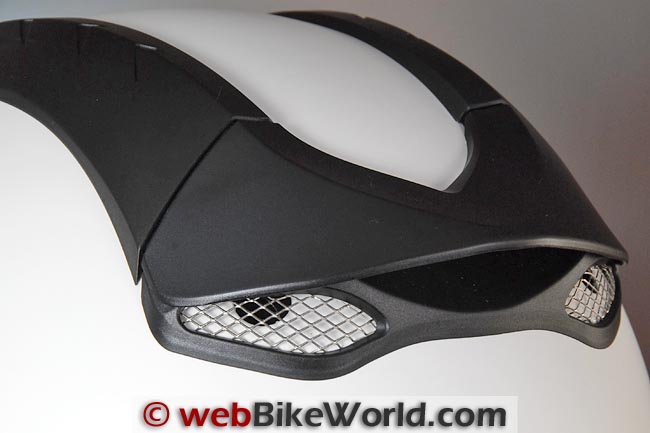
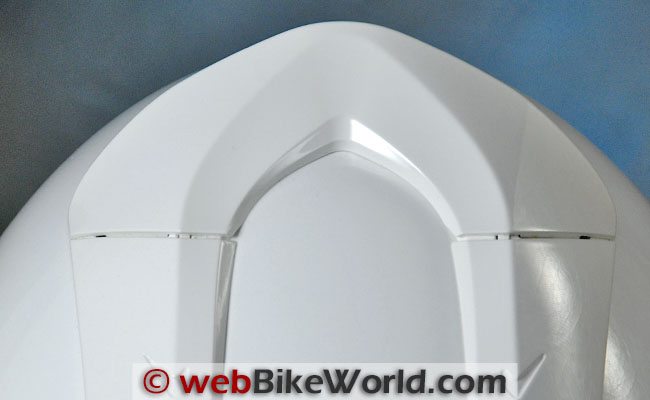
Pushing on it doesn’t help, by the way, so apparently closer tolerancing for the parts is called for. How about it, Schuberth?
The minor trim color differences between the DOT and ECE versions of the SR1 include all white trim instead of black on the white helmet and…that’s about it, as far as we can tell.
Also, the Matte White version is not available in the U.S.A., but that’s fine with me.
For some reason, the color choices for the SR1 DOT are currently limited to Gloss White and Gloss and Matte Black. There’s a “Technology” graphic version available for $70.00 more.
Let’s hope more colors are forthcoming, like maybe a Silver, Red, Blue, Safety Orange, High-Visibility Yellow and others.
Where to Buy SCHUBERTH SR1 DOT Helmet
Check Reviews & Prices on Amazon Check Reviews & Prices On RevZillaSee More Motorcycle Helmets, Motorcycle Visor, Motorcycle Intercom
Notes on SCHUBERTH SR1 DOT Helmet Fit, Internal Shape and Liner
Besides the overall quality feel and the included SCHUBERTH safety technologies, the best part of this helmet is that it fits me — and that is no mean feat, I can tell you that.
Apparently, I have an unusually-shaped head that is widest at the temples (“Earth” shaped), with a wide, flat forehead. On top of that, it measures 60.5 cm, which is exactly between standard Large and Extra-Large helmet sizes.
Thus, I have an extraordinarily difficult time finding a helmet that fits me comfortably. Most of the time, Large is too small and XL too big.
So would I spend more to get a helmet that actually fits? Absolutely, since spending less sometimes means throwing money away.
This SR1 fits very nicely; indeed, not since my dear departed Arai Quantum II (review) has a helmet fit like the SR1 in size XL.
The internal shape of the DOT version of the SR1 feels very similar (if slightly rounder) to the ECE version. The padding in both is also very plush, yet firm — just the way I like it. And the fabric used to line the helmet is also very comfortable.
As for its shape, it fits more like the Arai RX-Q (review) than the Arai Signet-Q (review), if that means anything.
The only issue for me is that the size XL in most helmets — including the SR1 — means the larger shell size. The SR1 DOT has three shell sizes to span the range, with the XL and XXL in the largest shell.
This means I’m the smallest head size in the largest shell size, which does result in some of that “fishbowl” effect for me; that is, the helmet shell feels larger than average for the head size.
The upside to the shell dimensions is a good feeling of security when I’m riding with the SR1.
If I had the choice, I’d rather go a bit larger than smaller, like some of the helmets where my chin sticks out the bottom. I don’t like that feeling very much…
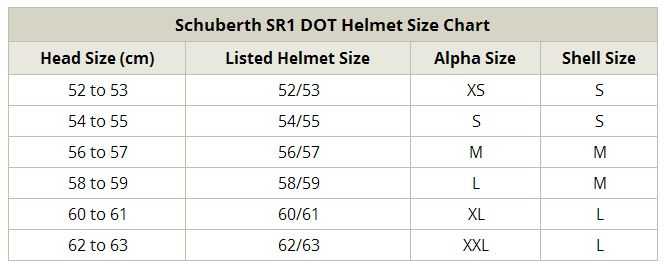
The DOT version of the SR1 has the same ear pocket design as the ECE version. I don’t know if it’s just me, but the tops of my ears get folded in slightly by the padding of the ear pocket.
The pockets feel like they could have about 10 mm more vertical spread on both versions of the SR1.
Otherwise, the helmet feels almost custom-made for my head shape, although I will rate the shape as “Neutral”. It’s definitely a different and less restrictive fit than the SCHUBERTH C3 DOT (review) in my opinion.
I’m not sure how SCHUBERTH classifies the internal shapes of their helmets but I haven’t been able to find a C3 that fits me comfortably and certainly not as comfortable as the SR1.
Since I have the ECE version of the SR1 here, trying both helmets on back-to-back seems to me to indicate that the DOT version perhaps has a very slightly wider fit, although this could be my imagination, or slight differences in padding, fabric, etc.
The bottom line is that either the ECE or DOT versions of the SR1 should fit a wide variety of head shapes with no problems.

More information on helmet fit can be found in the webBikeWorld Motorcycle Helmet FAQ page, along with the chart that lists the helmet weights of webBikeWorld reviewed helmets and also by shape on the webBikeWorld Motorcycle Helmet Shapes page.
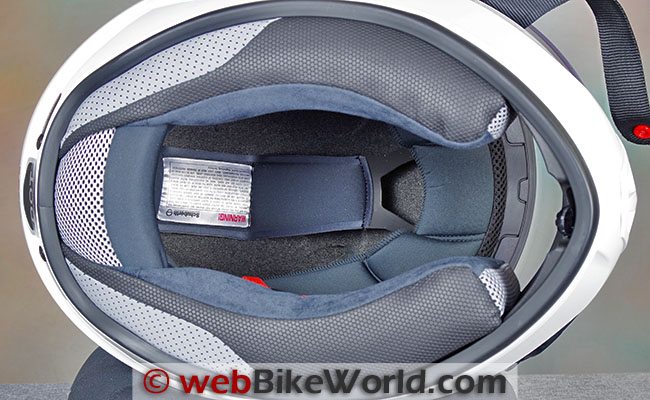
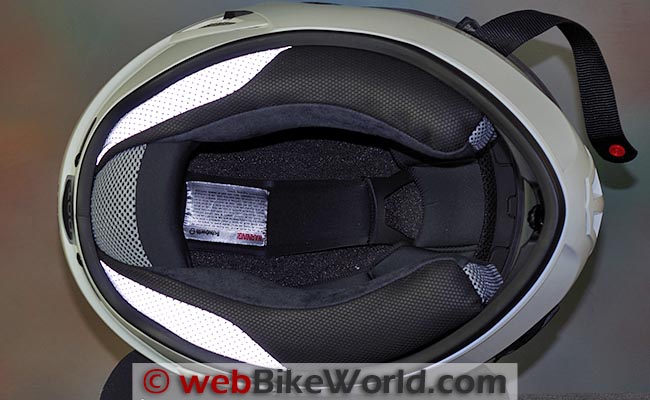
Where to Buy SCHUBERTH SR1 DOT Helmet
Check Reviews & Prices on Amazon Check Reviews & Prices On RevZillaSee More Motorcycle Helmets, Motorcycle Visor, Motorcycle Intercom
SCHUBERTH SR1 DOT: Other Details
I won’t repeat all the detailed information for the rest of the sections in my original SCHUBERTH SR1 ECE review because the helmets are so similar.
Suffice it to say that the visibility is the same, as is the ventilation, operation of the moving parts, chin strap and everything else. Also, the SR1 comes with a Pinlock-ready face shield and Pinlock insert in the box.
SCHUBERTH SR1 DOT vs. ECE Weight Differences
The biggest — and, other than the trim color — difference in the DOT version of the SR1 is the helmet weight. This is apparently due to meeting the FMVSS 218 U.S. DOT helmet safety standard (see my report on the differences between DOT, ECE and Snell helmet safety standards).
I’m not sure why some helmets claim to use the same shell to meet both DOT and ECE (and other) standards, but apparently the major players in the motorcycle helmet industry do not subscribe to that theory.
Arai, Nolan, Shoei and other higher-end brands seem to use different shells for the different standards — one of the reasons you pay extra.
There’s nothing wrong with the DOT standard by the way; in my opinion. But the different testing regime sometimes means a new helmet shell must be designed, which was the case with the SR1 and one of the reasons its introduction for the U.S. was delayed.
OK, so what’s the bottom line? The DOT version of the SR1 shown here in size XL weighs 1652 grams (3 lbs., 10-1/4 oz.).
That compares to 1438 grams (3 lbs., 2-3/4 oz.) for the ECE version I still have and which I reviewed in 2011. That is a difference of 214 grams (7.5 oz.).
1652 grams is still an excellent showing for a size XL helmet and, in fact, it’s still lighter than its two main size XL competitors in this segment: the Arai Corsair V (review) at 1758 grams and theShoei X-12 (review) at 1766 grams.
Also for reference, the e Shoei RF-1100 (review) in size XL weighs in at 1746 grams.
In reality, the 7.5 oz. difference can be felt if you’re handling both the ECE and DOT versions of the SR1, but anyone who hasn’t picked up an ECE sample will think the DOT version is just fine indeed.
So bottom line here is that this really isn’t an issue and the SR1 in its DOT guise is still a light helmet compared to its closest competitors. The very comfy fit and the aerodynamics help here also.
Other than the shell size, which feels a bit large in my particular circumstance, the SR1 feels well-balanced when riding the bike.
Note also that all of the helmets reviewed on webBikeWorld have been weighed and the weights are available on the wBW Motorcycle Helmet Weights page, along with a chart that lists the helmets by weight and shape on the wBW Motorcycle Helmet Shapes page.
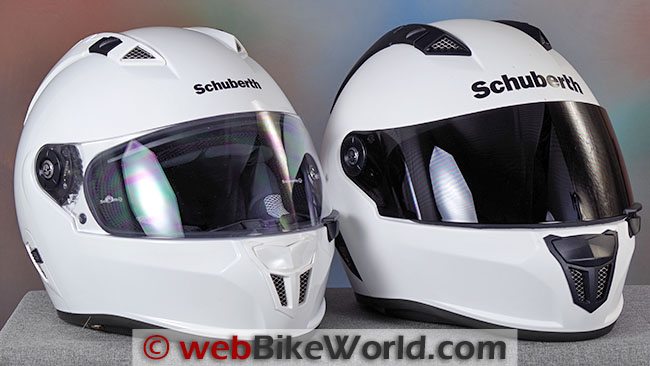
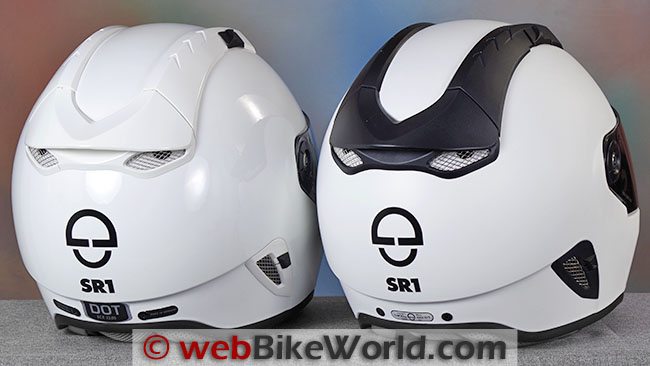
Miscellaneous
The SR1 ECE and DOT versions have a double D-ring chin strap system with comfortable padding underneath. The chin strap has snap retainer.
Here’s another reason why paying more gets you more: The SR1 DOT version has a 7 year warranty from SCHUBERTH (from the date of manufacture and for DOT helmets purchased in the U.S.A.).
This is quite good actually and, as far as we know, one of the longest motorcycle helmet warranties in the business. Our 2011 SR1 ECE version had a two-year warranty in Europe only.
But It’s a “Race” Helmet?
Don’t let the marketing-speak fool you. The SR1 is an excellent helmet for the street or track. It is one of my all-time favorite motorcycle helmets and I use it only on the street, on motorcycles of all types and my BMW C 650 GT scooter (blog)!
It’s more comfortable, feels more secure, flows way more air and is all-around a better helmet than just about anything else I can think of. That means I’ll wear it more often while feeling more comfortable and alert with fewer distractions, all important safety factors.
As I always say, the “best” helmet in the world is worthless if it doesn’t fit correctly and comfortably…
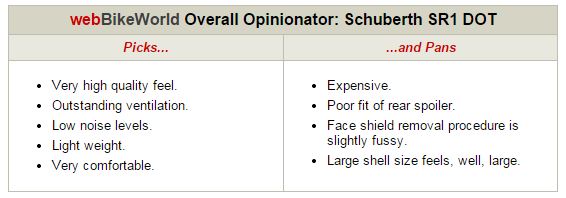
Conclusion
The SCHUBERTH SR1 DOT version feels just as good as the “original” ECE-spec version, and that’s a big relief. Yes, it is expensive — one of the most expensive motorcycle helmets you can buy.
Many riders will immediately discount it because of that, and that’s a shame.
To paraphrase the old saying, “If you have a hundred-buck head, buy a hundred-buck helmet”. I do not wear a helmet because I have to; I wear a helmet because I want to.
I want to give my head the best protection money can buy, but I also want exceptional ventilation, comfort and now noise levels. The SCHUBERTH SR1 is that helmet.
Where to Buy SCHUBERTH SR1 DOT Helmet
Check Reviews & Prices on Amazon Check Reviews & Prices On RevZillaSee More Motorcycle Helmets, Motorcycle Visor, Motorcycle Intercom
Owner Comments and Feedback
See details on submitting comments.
From “A.N.” (March 2013): “Just reading the SR1 review, I will get one to use on warmer days when my S2 is just too warm.
Just a note that may be of interest with regard to the SHARP testing: I had an accident whilst wearing a SCHUBERTH R1, now I have no memory of the accident (I may have had a stroke, but I certainly passed out). It was on a long straight piece of road.
The R1 has a crack in the RHS, about the temple area, where Sharp gives a poor rating for the helmet. I was “out” for about 6 hours. It took over a year, some titanium, several screws and some physio to get back to somewhere approaching normal, (the Hayabusa was repaired in a couple of days, despite the 100 meter slide on her exhaust pipe and clip on!).
I still ride the same bike and will always wear a Schuberth, it saved my life. Perhaps I should have contacted them to see if they could learn anything from the damage. My S2 was bought in Spain for 400 euros, the SR1 is a bit more, but not the most expensive helmet out there, but for me the best value for money.”
From “B.L.” (March 2013): “I have no doubt that the SCHUBERTH is a very good helmet but the UK Sharp Testing Website lists the ECE SR1 as a Four Star rating for safety. Using an interbank exchange rate of 1 USD to 0.66076 GB Pounds, the US helmet value is $899 USD or 594.67 GB Pounds.
From the same Sharp website, by setting the Rating at 5-star and the price maximum of 550 GBP, I can find 29 Full Face helmets that are nominally safer. So perhaps, from a safety perspective, the SR1 isn’t the one he should rather be wearing though for the exceptional ventilation, comfort and noise, it may be.”
Rick’s Reply: Note that the SHARP rating is for the ECE version of the helmet. Note also that it doesn’t matter how a particular helmet rates if it doesn’t fit correctly or isn’t comfortable. And, the SHARP tests are not recognized by any country as the standard for motorcycle helmet safety like, for example, DOT or ECE are.
No one really knows whether the Schuberth, Arai, Shoei, etc. will provide better or worse protection than any other helmet; that is the problem. Or how the SHARP or other lab-based testing regimes relate to actual real-world crashes. For example, it would be possible to design a helmet that would pass each of the individual SHARP (or DOT, Snell or ECE, etc.) tests in a lab and still not provide the right protection in a real-world crash instance.
It’s unfortunate that basically motorcyclists have to rely on the manufacturers’ marketing propaganda to try and determine if one helmet is truly better/safter/more protective than another. The current worldwide state of knowledge about real-world accidents and how that relates to helmet design is still fairly pathetic, all things considered.
One example: it would be nice to have riders wearing helmets with sensors and a “black box” to record real-world impact data, then use that information to develop better helmets.
Follow-up by “B.L.” (March 2013): “I did notice that your comments quite disparaged Sharp testing. Yes, it is not a safety standard but according to their website, they are just making this stuff up either. They only test helmets that meet the ECE standard which sets a minimum and then through their tests point out a performance level they have devised.
Their own impact speeds are the same as the ECE and BSA tests so they are just doing as a Helmet Manufacturer must do to meet the minimum rating to be allowed for use. They explain that they developed their levels by using the COST 327 Study which is real world based.http://sharp.direct.gov.uk/content/impact-zone-diagrams
They also point out that Fit is the most important but given a choice between two well fitting helmets, the star rating can be used as an additional factor to consider. http://sharp.direct.gov.uk/content/ratings.
Rick’s Reply: Thanks for the feedback. I think the problem is that motorcycle helmets are not designed for the SHARP criteria; they are designed for ECE, DOT and other recognized tests. So performing a different test on a helmet when the helmet isn’t designed for it and where there isn’t a lot of data backing it up (i.e. “more is better”) can lead to discrepancies. I think part of the problem is that there isn’t any data I know of that indicates success in SHARP tests means a better helmet or not.
Arai and Shoei have complained about this since the SHARP tests first came on the scene, yet many motorcycle racers still choose Arai and Shoei helmets for protection. And we’ve all seen the horrific racer crashes on TV, yet head injuries are actually pretty rare in motorcycle racing. That to me is much more definitive “real world” proof than any of the abstract standards to consider when choosing a helmet.
Also, there is a huge body of knowledge and research built up over the years that supports the accepted tests for ECE and DOT; much more than there is for SHARP.
To be honest, I’m a bit puzzled as to why so many riders put an emphasis on SHARP results. I’m not saying the SHARP tests are bad at all, and they certainly can be used as a data point when making a helmet decision.
One of the best outcomes of the SHARP system is the way they have created an easy-to-use website to provide the data and comparisons on helmets to the consumer with the SHARP website, which is an easy way to see and compare helmets. ECE and DOT are absolutely pathetic when it comes to that.
I feel sure that if ECE and DOT had the same type of easy-to-use comparative website where consumers could compare the actual ECE and DOT helmet test results, no one would even know the SHARP test existed!


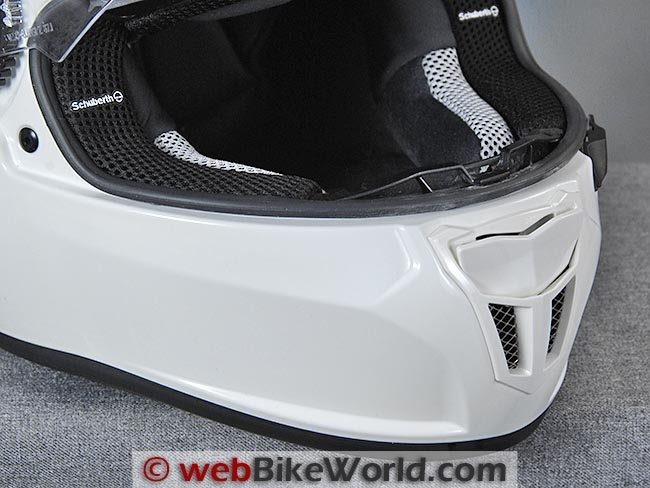
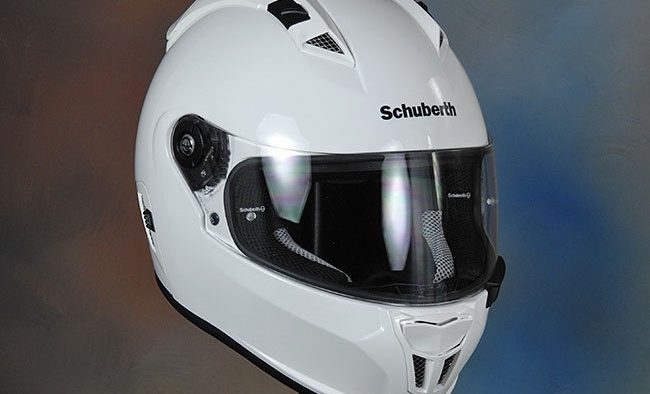
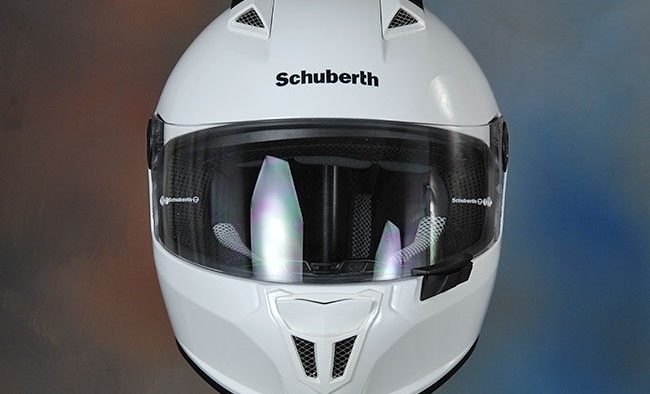
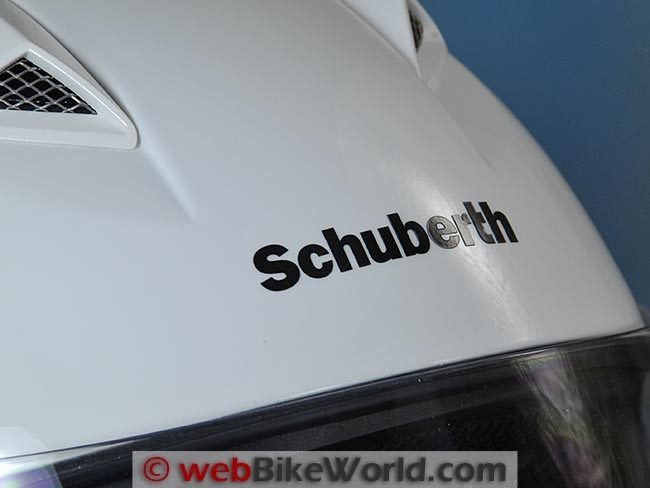
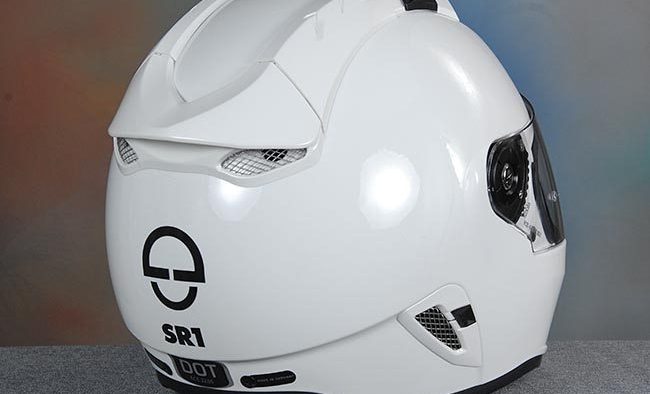
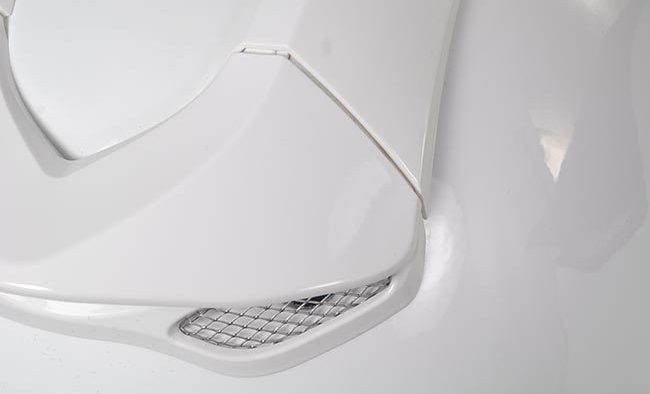
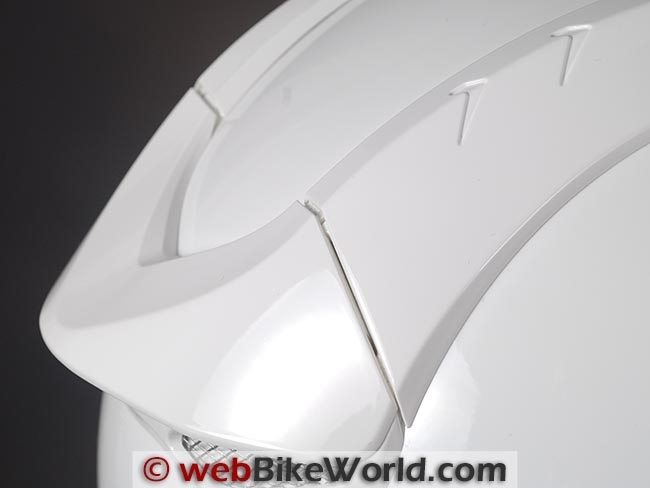
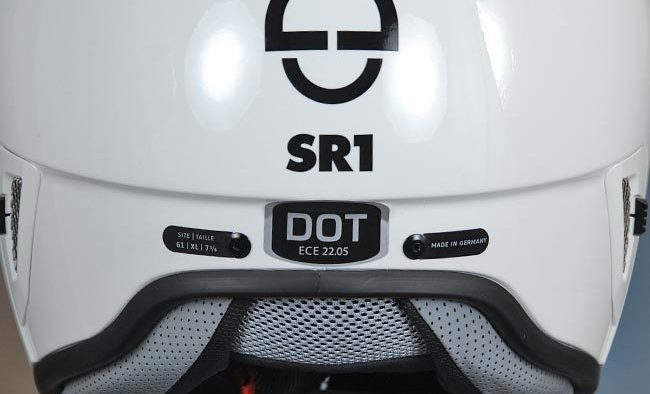


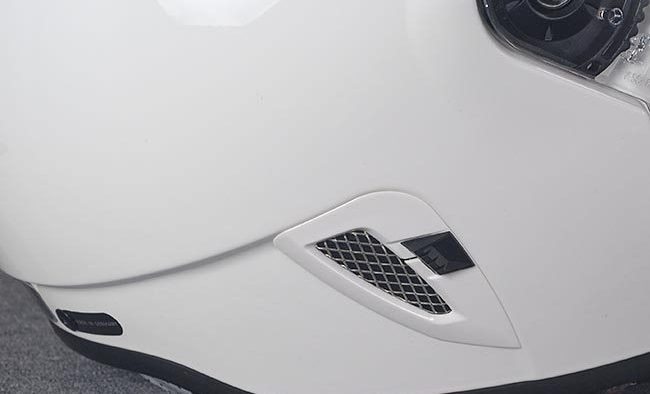
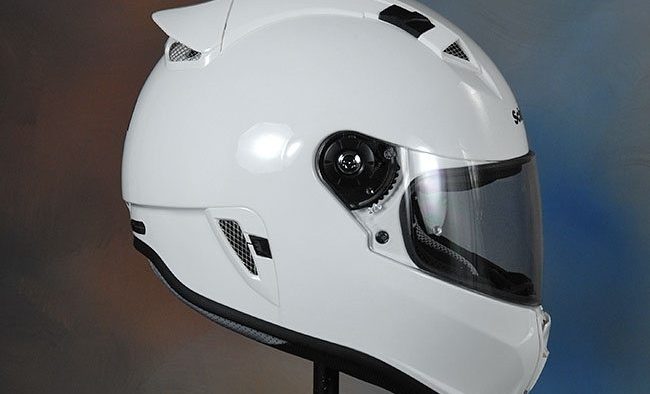
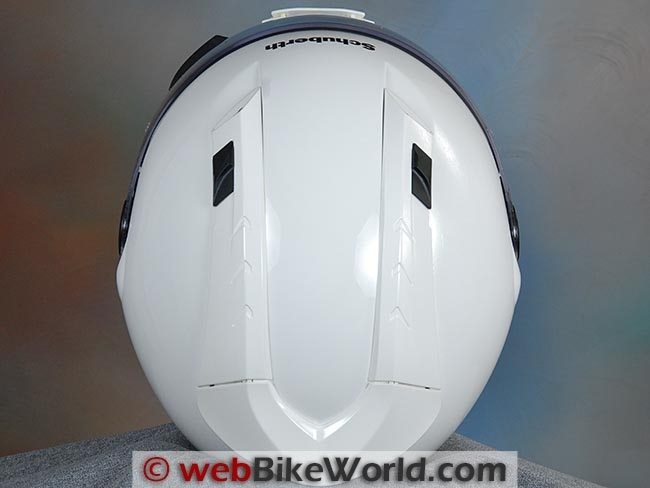
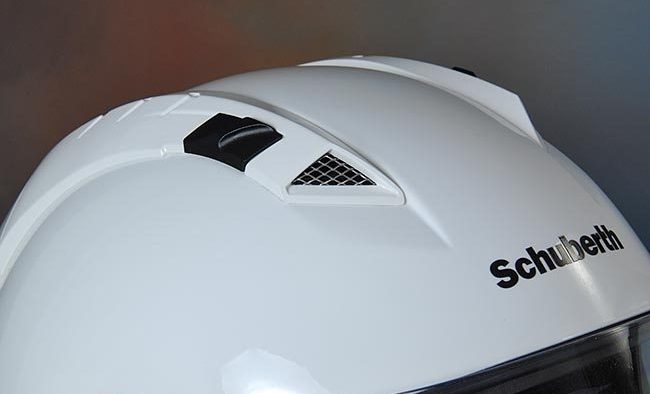
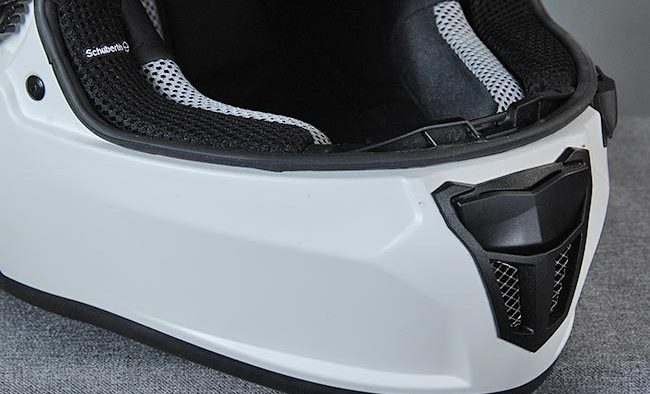

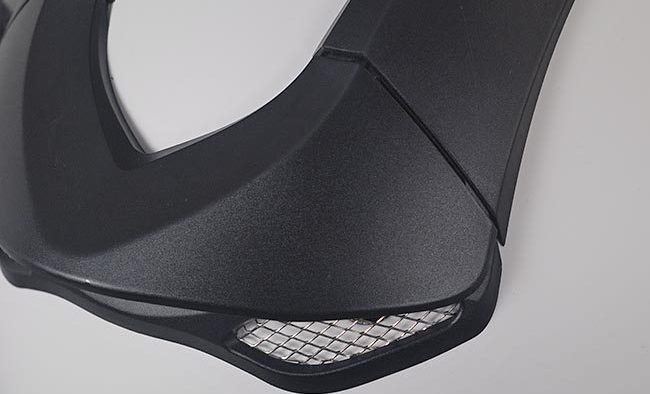
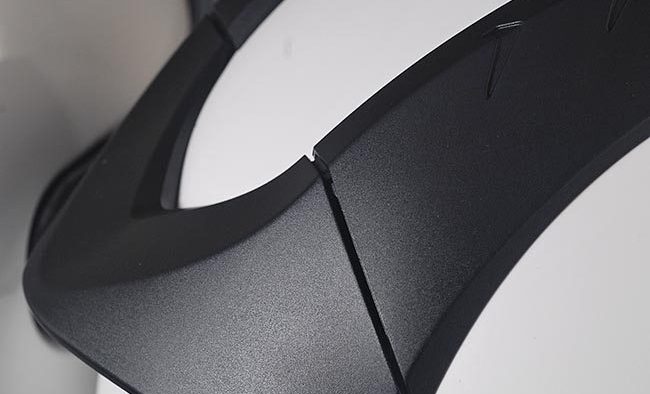
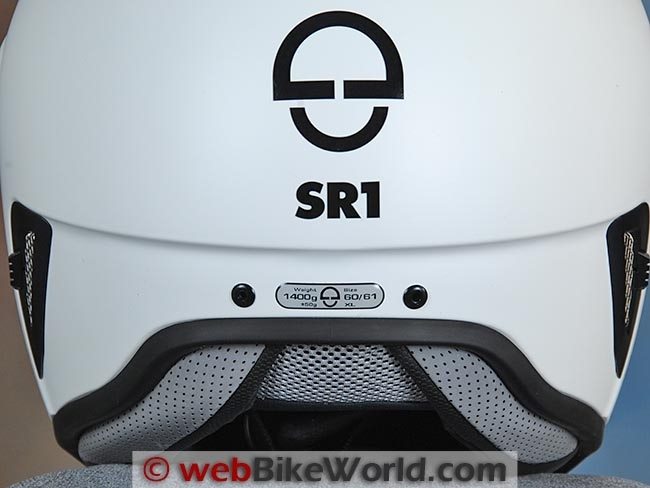
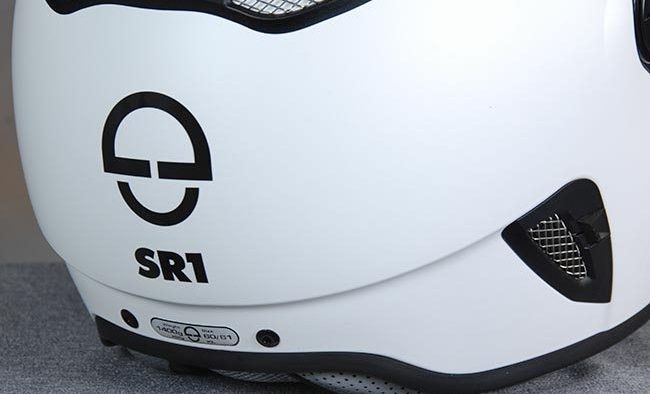
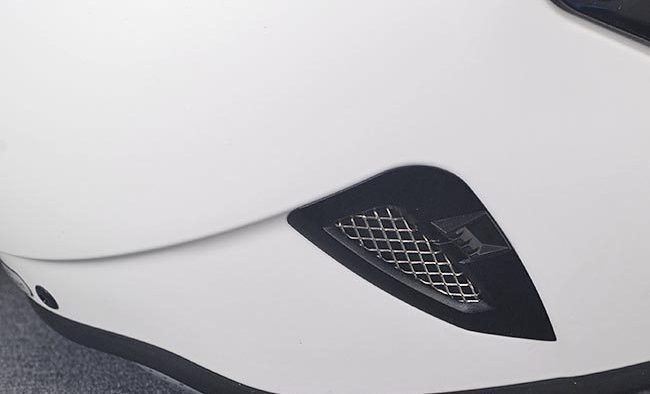
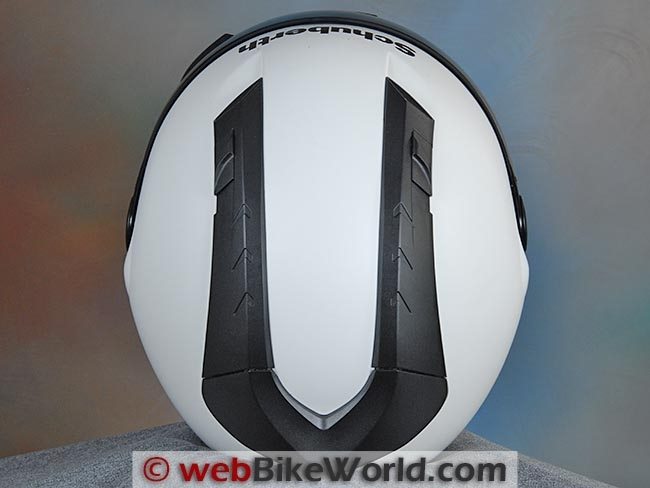
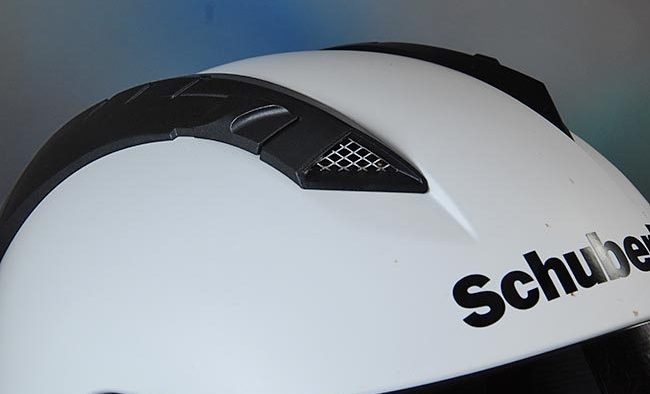

No Comment